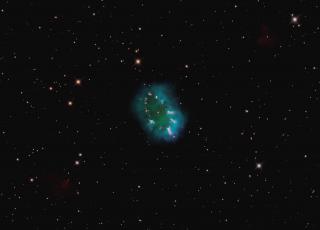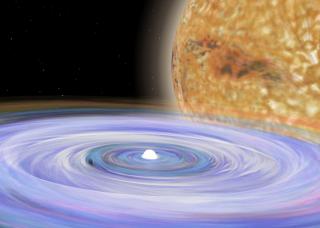Bibcode
Sowicka, P.; Jones, D.; Corradi, R. L. M.; Wesson, Roger; García-Rojas, J.; Santander-García, Miguel; Boffin, Henri M. J.; Rodríguez-Gil, P.
Bibliographical reference
Monthly Notices of the Royal Astronomical Society, Volume 471, Issue 3, p.3529-3546
Advertised on:
11
2017
Citations
29
Refereed citations
22
Description
We present a detailed analysis of IC 4776, a planetary nebula displaying
a morphology believed to be typical of central star binarity. The nebula
is shown to comprise a compact hourglass-shaped central region and a
pair of precessing jet-like structures. Time-resolved spectroscopy of
its central star reveals a periodic radial velocity variability
consistent with a binary system. Whilst the data are insufficient to
accurately determine the parameters of the binary, the most likely
solutions indicate that the secondary is probably a low-mass
main-sequence star. An empirical analysis of the chemical abundances in
IC 4776 indicates that the common-envelope phase may have cut short the
asymptotic giant branch evolution of the progenitor. Abundances
calculated from recombination lines are found to be discrepant by a
factor of approximately 2 relative to those calculated using
collisionally excited lines, suggesting a possible correlation between
low-abundance discrepancy factors and intermediate-period
post-common-envelope central stars and/or Wolf-Rayet central stars. The
detection of a radial velocity variability associated with the binarity
of the central star of IC 4776 may be indicative of a significant
population of (intermediate-period) post-common-envelope binary central
stars that would be undetected by classic photometric monitoring
techniques.
Related projects

Bipolar Nebulae
This project has three major objectives: 1) To determine the physico-chemical characteristics of bipolar planetary nebulae and symbiotic nebulae, to help understanding the origin of bipolarity and to test theoretical models, mainly models with binary central stars, aimed at explaining the observed morphology and kinematics. 2) To study the low
Antonio
Mampaso Recio
![Izquierda - Imagen RGB de la nebulosa de Orión y M43 obtenida filtros estrechos con la cámara WFC en el INT: H alfa (rojo), [S II] 6716+30 (verde), [O III] 5007 (azul). Derecha - Imagen en falso color de la nebulosa planetaria NGC 6778. En azul se ve la emisión en la línea de O II tomada con el filtro sintonizable azul del instrumento OSIRIS en el GTC; en verde imagen con el filtro estrecho de [O III] del Nordic Optical Telescope (NOT). Izquierda - Imagen RGB de la nebulosa de Orión y M43 obtenida filtros estrechos con la cámara WFC en el INT: H alfa (rojo), [S II] 6716+30 (verde), [O III] 5007 (azul). Derecha - Imagen en falso color de la nebulosa planetaria NGC 6778. En azul se ve la emisión en la línea de O II tomada con el filtro sintonizable azul del instrumento OSIRIS en el GTC; en verde imagen con el filtro estrecho de [O III] del Nordic Optical Telescope (NOT).](/sites/default/files/styles/crop_square_2_2_to_320px/public/images/project/imagen_web.jpg?itok=fsBmV9CO)
Physics of Ionized Nebulae
The research that is being carried out by the group can be condensed into two main lines: 1) Study of the structure, dynamics, physical conditions and chemical evolution of Galactic and extragalactic ionized nebulae through detailed analysis and modelization of their spectra. Investigation of chemical composition gradients along the disk of our
Jorge
García Rojas

Binary Stars
The study of binary stars is essential to stellar astrophysics. A large number of stars form and evolve within binary systems. Therefore, their study is fundamental to understand stellar and galactic evolution. Particularly relevant is that binary systems are still the best source of precise stellar mass and radius measurements. Research lines
Pablo
Rodríguez Gil